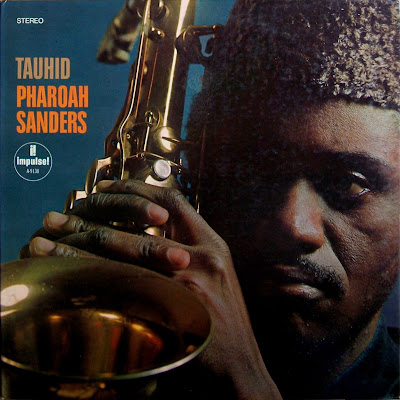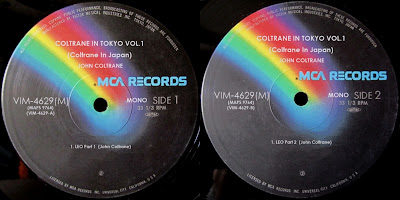Label:
Atlantic – SD 1481
Format:
Vinyl, LP, Album, Stereo / Country: US / Released: 1967
Style:
Post Bop, Avant-garde Jazz, Modal
Recorded
live at the Fillmore Auditorium in San Francisco 1967.
Design
[Cover Design] – Stanislaw Zagorski
Photography
By [Cover Photo] – Jim Marshall
Liner
Notes – George Avakian
Engineer
[Recording Engineer] – Wally Heider
Producer
– George Avakian
Matrix
/ Runout (Label Matrix Side 1): ST-A-671029 - A
Matrix
/ Runout (Label Matrix Side 2): ST-A-671030 - B
A1 - Tribal Dance .......................................................................................... 10:03
A1 - Tribal Dance .......................................................................................... 10:03
A2 - Temple Bells
............................................................................................
2:44
A3 - Is It Really The Same?
........................................................................... 5:45
A4 - Here There And Everywhere
.................................................................. 3:40
B1 - Love-In
....................................................................................................
4:44
B2 - Sunday Morning
..................................................................................... 7:55
B3 - Memphis Dues Again / Island Blues
....................................................... 8:57
Personnel:
Charles
Lloyd – tenor saxophone, flute
Keith
Jarrett – piano
Ron
McClure – bass
Jack
DeJohnette – drums, percussion
Round
five decades after the event, saxophonist Charles Lloyd's Love-In, recorded
live at San Francisco's Fillmore Auditorium in 1967, where his quartet was
opening for the Butterfield Blues Band—the first jazz group ever to play that
venue, the counterculture's West Coast music hub, endures as much as an
archaeological artifact as a musical document. From sleeve designer Stanislaw
Zagorski's treatment of Rolling Stone photographer Jim Marshall's cover shot,
through the album title and some of the track titles ("Tribal Dance,"
"Temple Bells"), and the inclusion of John Lennon and Paul
McCartney's "Here There and Everywhere," Love-In's semiology reeks of
the acid-drenched zeitgeist of the mid 1960s, a time when creative music flourished,
and rock fans were prepared to embrace jazz, provided the musicians did not
come on like their parents: juicers dressed in sharp suits exuding cynicism.
It
is likely that more joints were rolled on Love-In's cover than that of any
other jazz LP of the era, with the possible exception of saxophonists John
Coltrane's A Love Supreme (Impulse!, 1965) and Pharoah Sanders's Tauhid
(Impulse!, 1967). Chet Helms, a key mover and shaker in the West Coast
counterculture, spoke for many when he hailed the Lloyd quartet as "the
first psychedelic jazz group."
It
is to Lloyd's credit that, at least in the early stages of his adoption by the
counterculture, he resisted dumbing down his music. The adoption stemmed from
Lloyd's espoused attitude to society, his media savvy, his sartorial style and
his sheer nerve in playing jazz in the temples of rock culture. He took the
quartet into the Fillmore West three years before trumpeter Miles Davis took
his into the Fillmore East—as documented on Live at the Fillmore East, March 6
1970: It's About That Time (Columbia)—by which time his pianist, Keith Jarrett,
and drummer, Jack DeJohnette, were members of Davis' band (although Jarrett
didn't appear at the 1970 gig).
"I
play love vibrations," Lloyd told Time Magazine. "Bringing everyone together
in a joyous dance."
Love-In
was the follow-up to the amazing Dream Weaver, the debut of the Charles Lloyd
Quartet. Love-In was recorded after the 1966 summer blowout and showed a
temporary personnel change: Cecil McBee had left the group and was replaced by
Ron McClure. McClure didn't possess the aggressiveness of McBee, but he more
than compensated with his knowledge of the modal techniques used by Coltrane
and Coleman in their bands, and possessed an even more intricate lyricism to
make up for his more demure physicality. Of the seven selections here, four are
by Lloyd, two by pianist Keith Jarrett, and one by Lennon/McCartney
("Here, There and Everywhere"). Certainly the '60s youth movement was
making its mark on Lloyd, but he was making his mark on them, too. With young
Jarrett in the mix, turning the piano over in search of new harmonic languages
with which to engage not only Lloyd as a soloist but the rhythm section as
well, things were certainly moving across vast terrains of musical influence
and knowledge. Drummer Jack DeJohnette took it all in stride and tried to
introduce as many new time signatures into the breaks as he could get away
with, allowing the ever-shifting chromatics in Jarrett's playing to be his cue
from 7/8 to 9/8 to 12/16 and back to equal fours ("Sunday Morning,"
"Temple Bells," "Memphis Dues Again"), no matter what the
musical style was. And there were plenty, as Lloyd led the excursion from
post-bop to modal to blues to Eastern raga to cool and back. On Love-In,
everything was jazz for the Charles Lloyd Quartet, and what they made jazz from
opened the music up to everybody who heard it. The album is a lasting testament
to that cultural ecumenism.
Review
by Chris May / Thom Jurek
If
you find it, buy this album!






















































